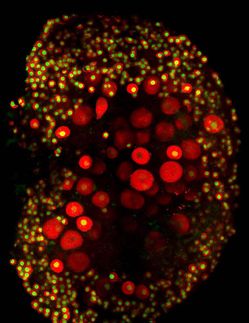Protein-mapping technology helps identify mutations in drug-resistant cells
Advertisement
The Children's Cancer Institute Australia (CCIA) is leading the fight against drug-resistant cancer using advanced protein-mapping technology from GE Healthcare. Two-dimensional gel technology called DIGE (2-D Fluorescence Difference Gel Electrophoresis), developed by GE Healthcare, is being used to study variations in the protein make-up of cancer cells that do not respond to chemotherapy treatment. The technology forms part of ongoing CCIA research that has led to a breakthrough discovery of cell mutations that confer resistance to anti-cancer drugs.
"Some cancer cells don't die when they're exposed to certain types of anti-cancer drugs; they may respond initially, but as treatment progresses a small number of cells can survive," said CCIA Group Leader Dr Maria Kavallaris. "In this way a patient may be doing well on the initial treatment, but when the cancer returns, the same drugs have no effect. It's this resistance to treatment that we're studying in an effort to understand why it happens and find solutions to the problem."
Kavallaris said there is evidence that cancer cells can 'acquire' resistance to certain drugs during treatment, and that some types of cancer cells are intrinsically resistant to those drugs.
"Before we can start looking for new therapies and treatments, we first need to understand the triggers for acquired and intrinsic resistance to existing treatments," she said. "We do that by identifying the proteins and protein pathways involved in drug resistance. Since proteins confer function in a cell - and the majority of today's anti-cancer drugs target proteins - by studying the protein profiles of drug-resistant cells we can hopefully determine where resistance occurs, why it occurs, and how to overcome it."
"DIGE uses special dyes called CyDye(tm) to label proteins in sensitive and resistant cells, which are then separated, laser-scanned and analysed using DeCyder software from GE Healthcare to spot differences as small as 10 per cent between protein samples. We can therefore quickly see which proteins have been lost, added or mutated in the resistant cells, and determine if and how they contribute to resistance." According to Kavallaris, the difference between using DIGE and older protein analysis techniques is literally months of time saved.

















































